|
KEEP THIS NEWSLETTER ALIVE! Shop Online at https://www.irishnation.com |
||

|

|

|
|
Marvellous Gifts! Family Crest Shields |
Family Crest Rings Signet, Shield and Seal |
Display your Heritage! Family Crest Flags |
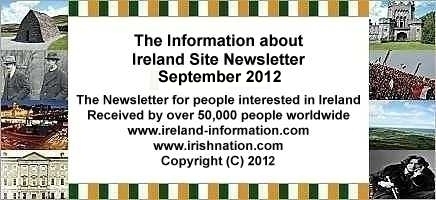
=============
IN THIS ISSUE
=============
=== News Snaps from Ireland
=== New Free Resources at the Site
=== Museum of Modern Art, Dublin
=== The Cliffs of Moher, County Clare
=== Saints and Skelligs by Nathan Kingerlee
=== A Dream Trip to Paradise by Olivia Mendez
=== Dermot and Strongbow & the Invasion of Ireland
=== YouTube Videos of Irish Interest
=== Gaelic Phrases of the Month
=== Monthly Free Competition Result
Popular Articles from recent Newsletters:
Natural Museum of Ireland - Archaeology
Famous Irish Songs: An Irish Lullaby
Ireland's Most Popular Tourist Attractions
Ancient Ireland #3: The Firbolg
==========
FOREWORD
==========
|
Ireland seems to be in something of a transition phase. On the one hand the devastating recession and consequent collapse of the banking system that nearly destroyed the country is still being dealt with. Unemployment remains at over 14% with emigration rising. The country has continued to function however and without the social breakdown problems experienced in Greece.
On the other hand there are signs that if the European debt crisis can finally be concluded than the country is well placed to recover. This may be several years away just yet but it seems that the very worst of the crisis is over for Ireland at least. Spain and Italy are only now really facing into the problems that Ireland has faced since 2008. Cause for optimism then? Or just another false dawn - time will tell. In this months newsletter we continue our examination of the very best tourist attractions in Ireland. We also offer a history article about one of the most infamous Irishmen ever: King Dermot MacMurrough, who is blamed for inviting the English into the country. That is quite a burden for any modern-day MacMurroughs to shoulder - we havent forgotten you know - we are keeping an eye on you! Enjoy your FREE Ireland Newsletter! Michael |

P.S. Please DO FORWARD this Newsletter to a
friend or relative. If you have a website or Facebook
page or Blog (or whatever!) then you can help
us out by putting a link on it to our website:
www.ireland-information.com
Do tell your friends about us as this helps
to keep this newsletter free!
SEND US YOUR PHOTOS OF IRELAND
Got any decent holiday snaps of Ireland - we want them!!
The Information about Ireland Site is compiling a
library of photographs of Ireland and specifically all
of the towns and tourist sites of the country. Photos of
any castle, lake, river, mountain, building, town,
landscape, tourist attraction or historic site are sought.
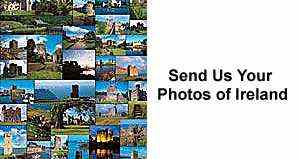
These photos will be made freely available for anyone
to use in their blogs, school reports, articles,
websites, facebook pages or projects.
Please contact us from here: https://www.irishnation.com/cgi-bin/contactfront.cgi
and we will send you further information. All contributors
will be entered (and re-entered every month) into a monthly
draw for a family crest print for the name of their choosing.
WE NEED YOUR HELP - CONTRIBUTE!
Got something to say? Don't keep it to yourself!
Why don't you submit an article for inclusion
in the next edition? Go here for more information:
https://www.ireland-information.com/newsletter.htm
Do you have access to a website? You can help to
keep this newsletter alive by adding a link to
any of our websites below:
https://www.irishnation.com
http://www.irishsurnames.com
https://www.ireland-information.com
http://www.allfamilycrests.com
http://www.irishpenpals.com
If you have an AOL or HOTMAIL account then you
may get better results by viewing this
newsletter online here:
https://www.ireland-information.com/sep12.htm
The only way that you could have been
subscribed to this newsletter is by filling
out a subscription form at the site whereupon
a confirmation notice would have been issued.
If you wish to unsubscribe then go here:
https://www.ireland-information.com/newsletter.htm
========================
NEWS SNAPS FROM IRELAND
========================
|
IRELAND TENTH BEST EDUCATED COUNTRY One consequence of the 'Celtic Tiger' economic boom in Ireland during the late nineties and early part of the new century was that there was a lot of investment in education. A recent report by the Organization for Economic Cooperation and Development (OECD) measured the extent to which the population of a country held a college or college equivalent degree. Between the year 2000 and 2010 the percentage of people with a higher level qualification in Ireland almost doubled, increasing at an annualized average rate of 7.3% - an astonishing increase by any standard. 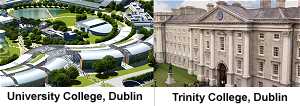
By 2010 Over 37% of the population had a higher level qualification, compared to 51% in Canada, 46% in Israel, 42% in the USA and 38% in the UK. Ireland ranked in tenth place in the list of OECD countries, with the USA fourth and the UK seventh placed. PROPERTY MARKET IMPROVES FOR SECOND MONTH RUNNING The single biggest monthly increase in property prices in Ireland for five years has fuelled hope that the bottom of the housing market has finally been reached. The economy of Ireland has been wrecked by excessive speculation in house and apartment developments as well as lax lending by banks in policies that were cheered on by political parties of all hues. The ruling Fianna Fail party were decimated at the last election with Fine Gael and Labour taking over. The ongoing problems in Europe have prevented any real recovery in the broader economy in Ireland but have also been a real drag on the property market and thus the construction industry which has traditionally been a huge employer in Ireland. It looks like a rebound of sorts is imminent but it remains to be seen what the scale will be like. There are still thousands of empty unfinished housing developments around the country, many of which will have to be demolished. There is also a reluctance on the part of the banks to lend to all but the most credit-worthy of clients. 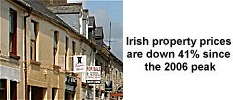
Despite these problems the Central Statistics Office announcement that house prices have risen by 0.5% in August is sure to encourage those who have been sitting on the fence, waiting for the market to finally 'bottom out'. Estate Agents estimate that prices in certain parts of Dublin City have risen as much as 4% since March. GOVERNMENT CRITICIZED OVER INACTION ON PUBLIC SERVICE The Fine Gael and Labour Party coalition Government are under increasing pressure over their inaction regarding the public sector pay bill. While it is broadly accepted that cuts to the pay of nurses and teachers, gardai and prison officers are often unjustified, the level of remuneration to those staff in the higher echelons of the civil and public service are well above the private sector average. In short, many public and civil servants are being paid ridiculously high wages given the fact that the country is bankrupt. The Government made a deal with the Unions known as the 'Croke Park Agreement'. No cuts to pay and there will be no strikes. 
This deal is coming back to haunt Fine Gael in particular. The Labour Party are happy enough with the arrangement as it protects the pay of the people who are most likely to vote for them in any election. Fine Gael though had promised sweeping reforms of all levels of government and had promised to run the country in a new way after the collapse of the previous Fianna Fail Government. Their failure to do so has been increasingly criticized by economists and commentators who are bewildered by the fact that the private sector are being forced to pay for a public sector it simply cannot afford, reducing their spending power, costing jobs. The honeymoon period for the current government is well and truly over and as they begin to enter the 'mid-term' of their governance the looming financial challenge of the end of year budget is acknowledged as their biggest challenge. The recent debacle where the Government cut only 1 out of a potential 1100 public service extra allowances simply highlights the frustration that is mounting in Ireland with the lack of progress. The next few months will be critical for this Government. NO END IN SITE TO DEBT CRISIS IN EUROPE The ongoing debt crisis that has engulfed Europe continues to drag on with commentators speculating that an end to the crisis is even years away. Already Greece, Portugal and Ireland have had to receive massive loans from the EU/IMF/ECB troika while Spain and Italy look set to be next. Successive attempts by the Germans and the ECB in particular to draw a line under the crisis have failed and despite the gloom lifting somewhat in recent weeks European leaders are once again on the back-foot as protests against austerity gain momentum in both Spain and Greece. 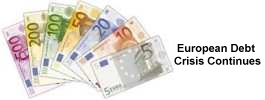
It seems that it is going to take a major shift in policy and/or massive debt-forgiveness/defaulting and/or a reduction in the size of the Eurozone to solve the crisis. Lots of permutations, very few answers. And all of this while unemployment continues to soar, dragging the world economy downwards. APPLE LEFT RED-FACED AFTER MAPS MISTAKES A new iPhone app released by Apple has been the source of equal measures of amusement and criticism in Ireland. The dodgy app identified Dublin Zoo as being located in the middle of Temple Bar, yards from O'Connell Street and the GPO where Padraig Pearse read the Easter 1916 Proclamation of Independence. The city farm named 'Airfield' in Dundrum in the south of the city was identified as an actual Airport which was probably a surprise to the sheep and cows who reside there. 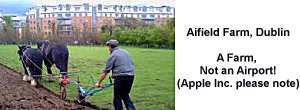
The mistakes prompted a member of the Irish Government to contact Apple requesting that they correct the incorrect information immediately. He was concerned that an airplane pilot may attempt a landing in the leafy suburban setting. Airfield director Kathy Purcell did see the lighter side of the debacle quipping 'We're having a bit of a laugh about it, but if someone did land, we'd welcome them with a hearty stew.' A 'hearty stew'... sounds nice! AMAZING VICTORY FOR EUROPE OVER USA IN RYDER CUP GOLF Trailing 10-6 going into the final days play it seemed that all the USA golfing team had to do was cruise to victory, requiring only 4.5 points from the final 12 matches. Despite near-fanatical home support the American team collapsed, allowing the gleeful Europeans to snatch perhaps the most famous victory in Ryder Cup history by a score of 14.5 to 13.5. 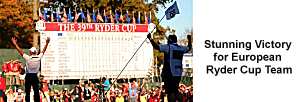
Voice your opinion on these news issues here: https://www.ireland-information.com/newsletterboard/wwwboard.html |
===============================
NEW FREE RESOURCES AT THE SITE
===============================
IRISH HOLIDAY AND TOURIST FORUM
Post your question about holidaying in Ireland and
we guarantee an answer will be posted on the board:
https://www.ireland-information.com/irishholidays-irishtourist/irishtouristboard.html

NEW COATS OF ARMS ADDED TO THE GALLERY
The following 5 coats of arms images and family
history details have been added to the Gallery:
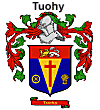
A: Athey
C: Colley, Corrigan
F: Fee
T: Tuohy
View the Gallery here:
http://www.irishsurnames.com/coatsofarms/gm.htm
THE PERFECT WEDDING, ANNIVERSARY OR BIRTHDAY GIFT!
We now have over 100,000 worldwide names available.
Get the Coat of Arms Print, Claddagh Ring,
Screensaver, Watch, T-Shirt Transfer or Clock for
your name at:
https://www.irishnation.com/familycrestgifts.htm
==========================================
IRELAND'S MOST POPULAR TOURIST ATTRACTIONS
==========================================
|
FREE ATTRACTION #4: IRISH MUSEUM OF MODERN ART, DUBLIN
The Irish Museum of Modern Art (IMMA) is located in the Royal Hospital in Kilmainham. The Museum is located near to Heuston Station and a short walk from the Luas (light railway tram) station at Heuston. There are plenty of buses travelling the quays as the Museum is located quite near to the River Liffey and is about a 10 to 15 minute drive. Although the Museum is quite near to the city centre it is not recommended that visitors walk to the site. 
The focus of the museum is to acquire contemporary artwork by living artists while maintaining a collection of art dating from the 1940s onwards. The Royal Hospital in Kilmainham is a formidable and impressive location and although a bit off the beaten track it is well worth a visit with its fine courtyard, noble facades and a restored baroque garden and chapel. There is an extensive exhibition program run by the museum with a cafe and bookshop located in the vaults. You can take an online tour of the Gallery at their website at: http://www.imma.ie/en/subnav_115.htm If modern art is your passion then the IMMA is sure to intrigue you. A day out to the Museum could be followed up with a visit to nearby Kilmainham Jail which is a short walk from the Museum. FEE-PAYING ATTRACTION #4: THE CLIFFS OF MOHER, CLARE The Cliffs of Moher are one of Ireland's most renowned tourist attractions. They offer stunning views out into the Atlantic Ocean and are 214 Metres high at the highest point. Located in County Clare in the western part of Ireland the site boasts a new 'Atlantic Edge' exhibition in the fine modern Visitor Centre. 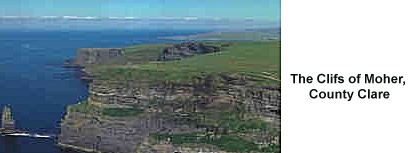
This is a great part of the country for self-driving although you can also take guided bus tours of which there are plenty. A fine day out might include a visit to the Cliffs in the morning and then into the depths of Ailwee Cave in the afternoon. Wrap up well - it can get very cold and, being Ireland, it can rain at any moment - any time and any place! You can take the online tour here: http://www.cliffsofmoher.ie/TakeTheTour.aspx |
KEEP THIS NEWSLETTER ALIVE!
Solve your gift problem at: https://www.irishnation.com

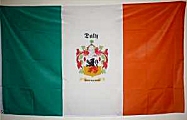
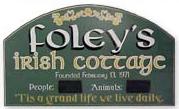
|
================== SAINTS AND SKELLIGS by Nathan Kingerlee ================== Long before Strongbow entered Ireland with his Welsh knights - at the invite of traitorous Irish king Dermot MacMurchada - the Irish were plundering the English and Welsh coastline. Wild and bearded Irish warriors stalked the Irish Sea, landing lightning attacks on unsuspecting settlements and Roman villas. They would loot and plunder what they could, carrying women and children back to Ireland into marriage and slavery. There are stories of highly planned kidnap and ransom missions, with Roman family members being safely reunited with their families once huge ransoms were paid. Like the Vikings many years later, for a time the Irish struck fear deep into the hearts of the English and Welsh, and also the Romans, who at the time were encamped in Britain. It was a plundering raiding party, looking for slaves and wives, who carried a Roman boy back to Ireland into a cold life of slavery. This fourteen year old Roman boy, Patrickus, grew to be Saint Patrick. This Welsh/Roman man has been adopted by the Irish as one of our patron saints, responsible for converting single handed a land of ruthless pagans into devout Christians, driving snakes from our green and rocky shores and trademarking the shamrock. The story of Saint Patrick is incredible and tough. He's even believed to have killed someone, possibly a lover, during his lifetime. In truth Christian missionaries were traveling Ireland's hills, forests and bogs before a newly ordained Patrickus returned to Ireland, having escaped from slavery in a row-boat several years earlier. Although he wasn't the first missionary to arrive in Ireland, when Patrickus returned as a priest, he had several things in his favor. After six years living here he knew the land, the people, the customs and the language. He was able to move relatively unhindered around the country and possibly because of his Roman noble descent he was treated with some respect. He was also here just at the right time, as the country was ready for the bells of Christianity to toll. The Irish pagans and druids worshipped several gods, including snakes. Certain groups of druids carried a snake tattoo emblazoned on their upper arm. The druids Patrickus wasn't able to convert (and there were many of them) he drove from Ireland - hence the connection with Patrickus driving all snakes from the country. 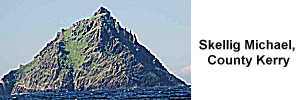
One of Ireland's furthermost outreaches is a brutally sharp protrusion of rock off the Kerry coast, which we now call Skellig Michael. Here stood the final outpost of druids and pagan worshipers - wild, rugged men, who called on many gods, threw curses across the country from atop of their rock and performed human sacrifices - or so Christianity viewed them. To this rock Patrickus travelled, alone and wary, in a little currach, to face his final battle. Here he faced his enemies and found his match. Men capable of performing human sacrifices and surviving a tough, tough life on these rocks stood against the stout heart and strong staff of Patrickus... For a day or more Patrickus argued and fought with the druids, until at last, weary, bloodied, dehydrated and faltering he drew together his final strength and called upon the archangel Michael to help. What happened next, whether the archangel Michael descended to assist, or whether Patrickus used his final strength, is not known, but he did succeed in driving the last of the Irish pagans off the black rock and out of Ireland and today this rock is known as Skellig Michael - The Rock of Michael. A monastery was built on Skellig Michael, and hardy monks made a life of worship and survival for themselves from the 6th to the 12th century. Wherever druids had settled and worshipped, the first Irish priests and monks would often build churches and monasteries in an effort to keep the displaced druids from returning and keep at bay the evil gods and spirits, whom to some extent were still half-believed and feared. This is exactly what happened on Skellig Michael, after being such a powerful pagan site for so long, there was no way Patrickus could leave it to its own menacing devices. Interestingly, one of the reasons that Skellig Michael was abandoned in the 12th century was because the Roman Catholic Church feared the monks and holy men living in remote locations were becoming too connected with nature, too in awe of the elements around them, and slipping into some of the pagan ways of life - so larger, more central monasteries were built with a more formal way of holy life and worship. The tiny village of Ballinskelligs, near Caherciveen, is where the monks from Skellig Michael were moved - Ballinskelligs meaning 'Homestead of the Rocks'. --- Nathan Kingerlee runs 'Outdoors Ireland' who provide adventure trips and guided tours in Counties Kerry ang Galway: http://www.outdoorsireland.com |
KEEP THIS NEWSLETTER ALIVE! Visit https://www.irishnation.com
|
======================= A DREAM TRIP TO PARADISE ======================= For many years I have been wanting to get to Ireland. My family is not Irish, my native language is not English and the traditions in my country are different from the Irish. Nevertheless, I have been so attracted to the 'green island' that I learned something of its history, traditions and tales, have enjoyed the music and dancing, and even have learnt and read great Irish poets and writers, the best in the English language I would say. After finishing my English Degree, I went into the Yeats Summer School in Sligo. One reason was to learn more about this amazing poet, but the most important reason was to finally meet Ireland in person. I arrived in Dublin at the end of July and had little chance to go around the city centre, since I had to register at the Yeats Society two days later. Fortunately I booked a central hotel in order to have more time to go around. The O'Connell Street is amazingly wide! It is a very busy street and with so much history on it. The river and the bridges give a romantic site to this modern and at the same time traditional city. When getting to the Trinity College, wow! it is like being in a different town, in a different world! You would really love to study there! Beautiful old buildings, full of history, culture and art. I went to the Gallery, the Writers Museum, but there were many other places I did not have the chance to see for lack of time. One day later I was taking the train towards Sligo, crossing the whole island to the northwest. This is, I believe, a very good choice in order to get to know the country sights, the way people in the different counties live. You can see lots of cows, sheep, and horses. Beautiful farms and lots, lots of green, green everywhere! Sligo is a small beautiful town, the people there are very proud of the Yeats' inheritance. Most of them have something to tell you about William Butler Yeats, about the places he lived at and wrote about in not few of his poems. They are always willing to help you find the right spot for a photograph, or the right place to learn more of the town and the surroundings. 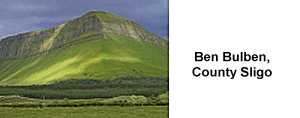
Knocknarea and Ben Bulben are huge mountains that seem to be keeping this little town, protecting it from the strong winds and the Atlantic Ocean. Although very tall, they can be climbed, and it is worth doing because when arriving at their top, the gift of having the chance to appreciate all the wonderful land below is priceless. Carrowmore megalitic cemetery and the other megalitic centres have a tight relation with Knocknarea which has a large tomb at the top. They all are geometrically connected for some reason the archaeologists still cannot figure out. Under Ben Bulben (as the title in the poem), at Drumcliff, lies the Yeats' grave, and one of the most ancient Celtic crosses on the island. This beautiful land is full of lakes, rivers, streams, falls and wells. 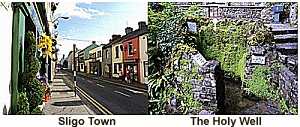
Lough Gill with its tiny islands, like Innisfree, is just a few minutes drive from town. The Garavogue river passes across the town and you can find lots of beautiful swans peacefully swimming in its waters. Glenndale Falls make you feel like being in a fairy tale, as much as the Holy Well, where any religion or kind of faith can be worshiped, after all, it's nature of the one who hold us all and protects us. There are so many things to do and visit in the western coast of Ireland you would need months to really get to know it, appreciate it, and breathe it in all its splendor. I am very proud to have accomplished my dream of going to this beautiful country, my version of paradise. Olivia Mendez Mexico City, Mexico |
KEEP THIS NEWSLETTER ALIVE! Visit https://www.irishnation.com
=================================================
DERMOT AND STRONGBOW, AND THE INVASION OF IRELAND
=================================================
|
Dermot MacMurrough was the King of Leinster during
the twelfth century and is most remembered as the
man who invited the English into Ireland.
He was born circa 1100 and succeeded to the throne of his father, Enna, in 1126. He was a ruthless leader and demonstrated the ferocity of the times by killing or blinding 17 rivals in 1141. He became involved in a dispute with the King of Breffney, Tiernan O'Ruark, whose wife he kidnapped in 1153. O'Ruark formed an alliance with Rory O'Connor who was the recognised High King of Ireland at the time. In 1166 this long-running and bitter feud resulted in MacMurrough being driven into exile by the Gaelic Chieftains. He fled to France. 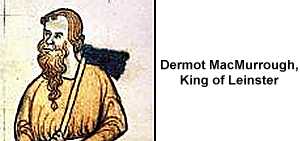
Dermot MacMurrough was a deeply ambitious man who refused to accept his exile. He made his way to the Court of Henry II of England and offered to become a vassal to the King in return for military aid in retaking his kingdom. The king did not directly provide assistance but allowed MacMurrough to petition the Anglo-Norman lords. It was at this time that the Earl of Pembroke, Richard de Clare, later known as 'Strongbow', agreed to lead an army to Ireland. MacMurrough brought an advance party of adventurers back to Ireland in 1167, recaptured Wexford, and waited for Strongbow to arrive. From his base in Wales Strongbow launched an offensive in 1170, capturing Waterford and Dublin, taking control of the East coast, much to the dismay of the Gaelic Chieftains and O'Connor. To cement the alliance, MacMurrough married his daughter Aoife to Strongbow, in Christchurch Cathedral in Dublin 1170. 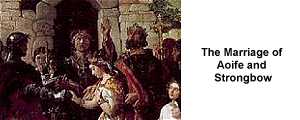
The Irish Chieftains did not allow the invaders to settle however and they were continually attacked and harassed. At one stage it seemed likely that they would be driven from the country if it were not for the support given by Henry II, who had become concerned with the amount of power and influence that Strongbow was amassing across the Irish sea. It is speculated that Henry II feared that Ireland might be used as a base by the Saxons to launch an offensive back into England in the wake of their defeat at Hastings in 1066. The subsequent domination of South Wales by the Normans was a result of the need to keep supply lines into Eastern Ireland open. Dermot MacMurrough died in 1170 leaving Strongbow to declare himself King of Leinster. His later support for Henry II in France led to his being named Governor of Ireland. He died in 1176 suffering an infection during a raid by Irish rebels. Much of Ireland was still under local influence and it only was the East coast, known as 'the Pale', that remained in Norman control. Henry granted these lands to his son 'Jean Sans-terre' (or John Lackland) in 1185 creating the 'Lordship of Ireland'. It seemed likely that Ireland would remain a minor Kingdom except that fate intervened. The death of his elder brothers allowed Jean Sans-terre to succeed to the English throne, becoming King John of England and the Pale becoming part of English dominated territories. 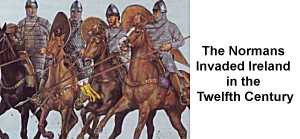
Demot MacMurrough has for centuries been blamed as the man who caused, or at least facilitated the invasion and subsequent subjugation of Ireland by outsiders. Recent revision of this history however, have been less critical of his actions. It is likely that the island would have eventually been dominated by its larger neighbour even without Dermot MacMurroughs prompting. The unwillingness of the Gaelic Chiefs to form a Kingship with defined rights of succession certainly made invasion and domination easier. It was also not uncommon of the times for Gaelic Chiefs to seek help from foreigners in combatting their local enemies. Despite this more generous interpretation of his actions, it will always be Dermot MacMurroughs lust for power, bringing the English into Ireland, for which he will be most remembered. |
==============================
YOUTUBE VIDEOS OF IRISH INTEREST
==============================
You can view our archive of Videos of Irish interest here:
https://www.ireland-information.com/irishvideos.htm
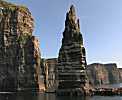
The Cliffs of Moher, County Clare
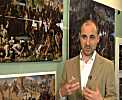
The Marriage of Strongbow & Aoife: The Famous Painting
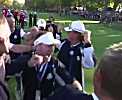
Europe wins the Ryder Cup, 2012
===========================
GAELIC PHRASES OF THE MONTH
===========================
PHRASE: Ta suil agam go bhfuil tu i mbarr na slainte
PRONOUNCED: taw su-ill ah-gum guh will tu ih marr nah slawn-che
MEANING: I hope you are in the best of health
PHRASE: Ni raibh am agam scriobh go dti seo
PRONOUNCED: knee rouh omm ah-gum skreevh guh dee shuh
MEANING: I hadn't time to write until now
PHRASE: Scriobh chugam go luath
PRONOUNCED: skreevh coo-gum guh lu-ah
MEANING: write to me soon
View the archive of phrases here:
https://www.ireland-information.com/irishphrases.htm
==================
COMPETITION RESULT
==================
The winner was: d_roache@xtra.co.nz
who will receive the following:
A Single Family Crest Print (decorative)
(US$19.99 value)

Send us an email to claim your print, and well done!
Remember that all subscribers to this
newsletter are automatically entered into the
competition every time.
I hope that you have enjoyed this issue.
Until next month,

Michael Green,
Editor,
The Information about Ireland Site.
https://www.ireland-information.com
Click here to contact us
KEEP THIS NEWSLETTER ALIVE! Visit https://www.irishnation.com